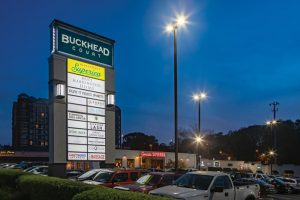— By David Goodwin —
Should I retrofit my sign with LED lights?
The commercial sign market has experienced a watershed shift in the use of one of a sign’s crucial components. Fluorescent bulbs long were the favored technology for giving signs their glow, but LED bulbs have emerged in recent years as a preferred choice for many sign-makers and their customers.

David Goodwin, Ad Vice Studios
Newly fabricated signs now often are installed with LED bulbs. In addition, shopping center operators and others increasingly are weighing the value of retrofitting their existing signs with new LED bulbs.
A LED retrofit comes at an upfront cost. The ballast, trays and electronics must be replaced, along with the bulbs. However, LED bulbs provide an array of key advantages that often make a retrofit an attractive option that is well worth the investment. If you are wondering whether a retrofit is right for you, here are some of the critical benefits to consider.
A Low-Maintenance Relationship
LED bulbs last approximately 10 times longer than their fluorescent counterparts before expiring and going dark. This can create major financial savings over the long term. Fluorescent bulbs’ shorter lifespan leads to a need to replace dead bulbs in signs at least once a year — and sometimes even more often. Meanwhile, LED bulbs can burn without replacement for up to 10 years. In addition, fluorescent bulbs are more fragile than LED bulbs and therefore more susceptible to breakage due to less-than-ideal conditions, such as severe weather.
Maintenance visits to replace dead fluorescent bulbs are more complex than a simple stop by a technician to unscrew one bulb and screw another one into place. Instead, the replacement process can require multiple technicians, replacement of the accompanying ballasts, special equipment — such as a bucket truck — and proper disposal of the fluorescent bulb. The costs of these re-placement procedures begin to add up, especially when placed alongside the often nonexistent costs of maintaining LED bulbs.
 The diminished need for repairs also saves valuable staff time for property managers and other key facility personnel who can devote their hours to other responsibilities, such as those that help generate revenue, rather than dedicating effort to overseeing the maintenance schedule and related duties for sign upkeep.
The diminished need for repairs also saves valuable staff time for property managers and other key facility personnel who can devote their hours to other responsibilities, such as those that help generate revenue, rather than dedicating effort to overseeing the maintenance schedule and related duties for sign upkeep.
Keeping Up Appearances
Aesthetically, LED bulbs do not differ in any meaningful way from fluorescent bulbs — as long as the fluorescent bulbs are lit. However, LEDs’ lengthier lifespan has a major impact on the appearance of a sign because the use of LED bulbs dramatically reduces the instances when a sign is afflicted by burn-outs.
Nothing more undermines the professional competence you hope to convey to your customers than unlit or otherwise faltering bulbs, which can project carelessness or disinterest to passersby. However, routinely burned-out bulbs are an accepted part of life with fluorescents. The goal is to get them changed promptly. In contrast, LED bulbs’ endurance guarantees a more sustained, consistent appearance that will exude the image you want.
A Greener Choice
LED bulbs produce more light per watt than fluorescent bulbs, meaning they produce energy savings on a day-to-day basis when compared to fluorescents. Although the savings ultimately are modest, LED bulbs also do not carry the same environmental risks as fluorescent bulbs, which contain mercury — a chemical that is harmful to the environment and a health risk for humans.
For those reasons, a LED retrofit amounts to a step toward a greener, more sustainable business enterprise. Shopping centers and others that seek to project a brand of environmental responsibility and good citizenship to their customers will find LED bulbs to be a key asset in that area.
— David Goodwin is the president of Ad Vice Studios, a Richmond, Virginia-based sign making and marketing services company. Goodwin has built his career and his business collaborating with property managers, developers and architects to transform commercial properties into attractive destinations with unique brands and customer experiences. For more information, visit www.advicestudios.com.
